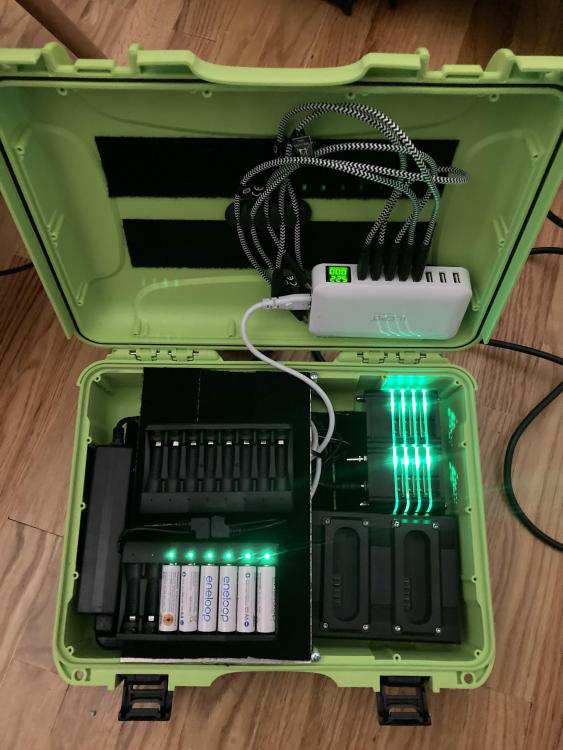-
Posts
564 -
Joined
-
Last visited
-
Days Won
9
Content Type
Forums
Gallery
Store
Posts posted by Shastapete
-
-
703 is excellent by itself for acoustic room control. Why are you hung up on fake fur? I wouldn't go near it unless it's an aesthetic choice – useless for sound control
-
No one's ever looked at my batteries, but they're all less than 100Wh and ALWAYS in my carry on bag – and in a bag inside that just in case I can't get my bag on the plane and need to pull those batteries out. I should have contact covers on them... but I don't
-
21 minutes ago, thesound said:
PTFE thread seal tape is a good idea, as long as the threads don’t have to conduct electricity.…
The threads are the mic ground, so probably not a good idea
Maybe a tiny dab of loctite purple (lowest strength) would work… but I’d test that on a mic and adapter that you don’t mind glueing if it is too strong
-
6 hours ago, Fred Salles said:
Am I the only one with the bitter feeling that this should be part of a free update and not an extra cost plug-in?
Zaxcom upgraded all Novas from 12 channels to 16 channels for free
-
4 hours ago, Jim Feeley said:
A couple months ago, I bought a Sanken CS-M1. About 100mm (4-inches) long, supercardioid, sounds good. Also, US$900. Perhaps more than you want to spend, but it also works on a boom. 🙂 I like compact size; so do camera operators. Can you swing by a place and compare something like the CS-M1, the AT875, and something from your homies at Rode?
https://www.sankenmicrophones.com/production/shotgun/cs-m1/
I have a pair of these, They've become my primary mic for documentary interview shoots (Axios on HBO, ESPN, and several others) I don't know if I can stomach "wasting" it as a camera mic. I have a Deity Smic 2S relegated for that duty when the cam doesn't have their own. (I'd suggest getting the short version, that didn't exist when I bought mine)
-
https://www.powerstream.com/Wire_Size.htm
Just glancing at a few – it looks like they are 24 gauge, which has a max current of 3.5amps in chassis wiring, and half an amp for power transmission. (In a charging case, I think you can lean more towards the chassis wiring specification, but I believe they shouldn't be paired in that configuration, just free wires.)
So the rating says no, but you can try it, and if it melts then you know for sure you undersized your wires
-
Personally, I view the distinction of Production Sound Mixer vs. Sound Recordist the same as Cinematographer vs. Videographer.
-
14 hours ago, sciproductions said:
What is a "humkiller"?
An inline transformer used to isolate his bag from any ground loop problems coming from the production truck.
This is one from Sescom: https://www.sescom.com/products/view/product/productslug/il-19-pro-audio-hum-eliminator-inline-with-isolation
-
18 hours ago, tolachi said:
I only played with it once, had to really crank the gain to get it sounding right. But the self noise didn't seem to be a problem (listening to a city street)
-
4 hours ago, DanieldH said:
I am having a déjà-vu with this discussion about this product/service.
And one, that this thread will be moved to the "manufacurers and dealers" section.
Turi spams viviana everywhere
-
Raw battery cells are the individual batteries (like the 18680 lithium cell in your photo). A battery package contains the required number of cells in series/parallel arrangement and a Battery Management System (BMS) board. A BMS is required in front of any multi-cell battery. The board protects against over discharge, hight/low pack temperature, shot circuits, uneven cell voltages, and a number of other things that can at a minimum impact the life of the battery and at most keep it from exploding.
-
Your idea has a couple flaws – the first is that there isn't any fall over between the power inputs on the Nova – they will just draw from whatever battery has the highest voltage. So your "backup pack" will add to the battery life of your system but not work the way you want it to.
The Nova has a power range of 8 - 18v.A 4S lithium battery (with 3.7v 18650 cells) has a nominal voltage of 14.4v and a useful range of 16.8v to a low voltage cutoff of 10v (but a safe cutoff of 12v)
A 3S lithium battery has a nominal voltage of 10.8v and a range of 12.6v to 7.2v (with a safe cutoff of 9v)
So with those 2 battery configurations, you can safely cover the voltage range of the Nova with a smooth handoff of current draw from one battery to the other (as the current will come from the battery with the highest voltage)The second flaw in your proposed batteries is a battery management system (board) as raw cells can be easily destroyed if you draw them down too low, which the Nova would happily do as it's cut off voltage is lower than the battery's discharge limits. Additionally "raw" cells aren't supposed to be used out of battery packs, they are, but it is risky.
Something I've been considering (but haven't pulled the trigger yet) as I already use the smart batteries, is to get a small 3S battery as power backup, like https://inspired-energy.com/products/n-series-batteries/details/3/4-nc2040hd29 as it can be charged on the same chargers and use the same battery connector – and will work as a fall over supply
but the other option, and probably more reasonably, is to just use that second shoe and just add a fresh battery when the first one gets low (as the new battery will take the load, as it is fresh off the charger, and the voltage is higher) -
@Fred SallesThe lowest-profile locking 1/8" connector I've found is from Cable Techniques.
https://www.cabletechniques.com/product-page/mini-3-5mm-trs-lopro-locking-connector-moulded-assembly-39It's a moulded assembly with wire attached, so you just need to terminate the one end, and you're good to go.
-
I also just ordered one, should get to me end of the week, will report back my findings/opinion as well.
I plan to pair it with a DPA 4017b and/or the Sanken CS-M1
-
As with all of Proaim's products, that cart is a knock off of PSC's sound cart https://professionalsound.com/specs/soundcart.htm, their other sound cart is a knock off of Inovativ's "Deploy" https://www.inovativ.com/deploy-gen-iv/
-
2 hours ago, Spin360 said:
Sorry for off-topic question, but what did happen? All I know is camera operator was killed by Alec Baldwin, sadly.
Does it have to do with the strike?
There are a lot of news articles so you can easily find this information.
It had nothing to do with the strike, it was a low budget film who hired very inexperienced crew in very important positions. Crew was using prop guns for target shooting between setups, live ammunition was on set, a prop gun was given to an actor without any safety checks and called a "Cold Gun", unfortunately it still contained real ammunition. We know the rest.
Union camera members walked off the set that morning due to safety (and pay) concerns. -

1/8" stereo mic/line input, and BNC timecode
-
-
I use the GoButton ipad app for any Cue to Cue and soundboard needs (same people as QLab)
It's free for one show at a time, but it's all one offs for me, so I've never felt the need to upgrade to pro for $100 -
Did you connect them in Dante Controller?
-
Sounds like 2.4ghz getting into the headphone cable/amplifier circuit. It used to happen with Zaxnet and my F8 – never had a problem since getting the Nova.
On 9/30/2021 at 8:32 AM, kavenzmann said:Any ideas, how I can get around that?
Move them further apart, add some sort of RF shielding between them, isolate your power connections (could be coming in through the shared ground), or upgrade your wireless -
24bit, always – 16 bit provides you with 96dB of dynamic range between the noise floor and 0dBFS. 24 bit provides you with 144dB. So yes, you're likely fitting all you need to in the 16bit word, you get so much more room in the 24bit file AND the post production workflow is standardized at that level.
Yes, 32bit is more – but the post workflow isn't there yet
-
1 hour ago, Jim Feeley said:
OK all you CS-M1 aficionados... What mounts are you using with it?
I have the INV-6 (black) and INV-6 Heavy (Gray) depending on if I'm using a furry or doing more running and gunning.
I also use the Gray INV-6 with my DPA 4017c, as the black has a bit too much flx even with foam
-
2 hours ago, Franctir said:
40 Hz -18db/oct on both channel (sure it's not enough)
Yeah, that setting is basically useless. I'd start at 60Hz and move it up until you like the sound. Mine usually sits around 80Hz, but sometimes with aggressive booming, windy conditions, or whatever else I've even had it up at 120Hz – when I did post mixing, I'd always throw another low cut on killing everything below there anyways

.png.279748a58a2b862b7aa5f3b84126e232.png)




fake fur black fabric for acoustics control on cardboard instead of furniture blanket?
in General Discussion
Posted
Rockwool is an insulation company. Safe'n'sound is their acoustic insulation product.
https://www.rockwool.com/north-america/products-and-applications/products/safensound/?selectedCat=safensound® downloads
Owens Corning 703 (without any facing) is another very effective acoustic insulation.
https://www.owenscorning.com/en-us/insulation/products/700-series-fiberglas-insulation
703 does slightly better at stoping sound transmission overall, but it is more expensive.
Frequency 125 250 500 1000 2000 4000 Overall
3" OC703 0.31 1.07 1.26 1.15 1.05 0.97 1.15
3" RW SnS 0.52 0.96 1.18 1.07 1.05 1.05 1.05